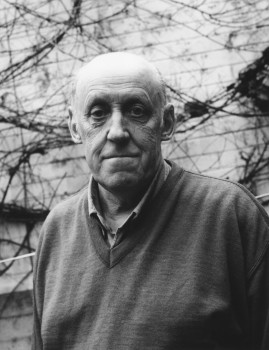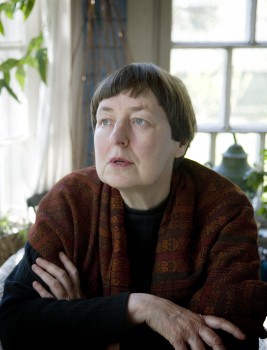Tag: fantasy
Delina
Issue 3/1999 | Archives online, Fiction, Prose
A short story from Löytöretkeilijä ja muita eksyneitä (‘The explorer and other lost people’, Tammi, 1999). Introduction by Soila Lehtonen
The stranger met Delina at a development organisation’s work camp, but Delina was not a volunteer. Delina lived in the country permanently.
The stranger did not spend very much time in Delina’s company. His evenings were spent with fellow-volunteers in the village cafe, where Delina’s parents did not allow her to go. During the day, both of them worked in their separate ways: Delina at home and the stranger in the work camp’s fields.
The stranger did, however, get to know the girl well enough to hear that she was in love with a soldier called Zmiri from the nearest garrison. This soldier was arrested once when he and his comrades drunkenly molested volunteers – but Delina knew nothing of the case. More…
The son of the chimera
30 September 1999 | Fiction, Prose
A short story from Pereat mundus. Romaani, eräänlainen (‘Pereat mundus. A novel, sort of’, WSOY, 1998)
I was born, but not because anyone wanted it to happen. No one even knew it was possible, for my mother was a human being, my father a chimera. He was one of the first multi-species hybrids.
Only one picture of my father survives. It is not a photograph, but a water-colour, painted by my mother. My father is sitting in an armchair, book in hand, one cloven hoof placed delicately on top of the other. According to my mother, he liked to leaf through illustrated books, although he never learned to read. He is wearing an elegant, muted blue suit jacket, but no trousers at all. Thick grey fur covers his strong legs, right down to his hoofs. Small horns curve gracefully over his convex forehead. Striking in his face are his round, yellow eyes, his extraordinarily wide mouth, his tiny chin and his surprisingly large but flat nose. More…
Punishment and delight
Issue 4/1995 | Archives online, Fiction, Prose
Extracts from Pimeästä maasta (‘Out of the Land of Darkness’, Kirjayhtymä, 1995). Interview by Jukka Petäjä
‘A being far more powerful and wiser than ourselves made the mould at the beginning of time and set it up for us as a model in order that we might shape ourselves correctly,’ the teachers said. ‘The Prime Mover’s form, actions and thoughts we are unable to understand. The Prime Mover gave us the mould in order that we should not remain formless. To this extent it has made itself known to us, although we do not deserve anything from it. It did not make the mould of bog-iron, which would soon have rusted in the cellar, but of a much better material of which we know nothing, and need to know nothing. Our duty is to aspire to fill the perfect mould given to us perfectly. Most of us will never be able to do so, for we are worthless, formless, unclean messes who deserve, many times over, all the pain of fitting the mould.’
Ulthyraja Tharabereghist did not dare ask anything, but there was something she would have liked to know. How the Prime Mover had made the mould, at least, and where it had found the materials, and what the Mover had gone on to do and where it had gone when the mould was ready and in the possession of the villagers. Even illicit thoughts were said to damage one’s shape: to be visible in it, if one knew how to look, and, of course, to be felt in the pains of fitting the mould… More…
Adieu, Paris!
Issue 4/1994 | Archives online, Fiction, Prose
One day an Indian physicist discovers that Paris has disappeared – or, in the words of the French government, has been relocated: ‘it now exists not merely in one place, but in many, perhaps not precisely here or there, but to some extent everywhere’. Extracts from the novel Kadonnut Pariisi (‘Paris lost’, Otava, 1994)
The news of the disappearance of Paris was, at first, an item in the remotest corners of the foreign news pages of the newspapers and in the light feature at the end of the television news – those absurd little stories: an elephant’s escape from the zoo, the mother of four who beat the world record for toothbrush-swallowing or the suicide of a news reporter in the middle of a television broadcast.
Professor Ansari, an Indian physicist, had developed a method for the extremely accurate measurement of the mass of the Earth. His conclusion was that the Earth weighed too little. And, by an extraordinary coincidence, the missing mass was approximately the same as the estimated mass of Paris. The physicist was foolish enough to make his result public and to utter the fateful words: ‘Well, of course the simplest explanation would be that Paris is missing. That it doesn’t exist any more.’ A news item on the subject in the ‘Crazy World’ column concluded with the remark: ‘Professor Ansari is continuing the development of his theory in the government mental asylum in Delhi.’ More…
Gorgonoids
Issue 1/1993 | Archives online, Fiction, Prose
From Matemaattisia olioita tai jaettuja unia (‘Mathematical creatures, or shared dreams’, WSOY, 1992). Introduction by Soila Lehtonen
The egg of the gorgonoid is, of course, not smooth. Unlike a hen’s egg, its surface texture is noticeably uneven. Under its reddish, leather skin bulge what look like thick cords, distantly reminiscent of fingers. Flexible, multiply jointed fingers, entwined – or, rather, squeezed into a fist.
But what can those ‘fingers’ be?
None other than embryo of the gorgonoid itself.
For the gorgonoid is made up of two ‘cables’. One forms itself into a ring; the other wraps round it in a spiral, as if combining with itself. Young gorgonoids that have just broken out of their shells are pale and striped with red. Their colouring is like the peppermint candies you can buy at any city kiosk. More…
Invisible cities
Issue 4/1992 | Archives online, Essays
Extracts from Leena Krohn’s collection of essays, Rapina ja muita papereita (‘Rustle, and other papers’, WSOY, 1989).
Past me hurries a man in a rustling anorak. He pushes a card into a crack in the wall. There is a whirring noise, a door opens and, shoulder first, he pushes his way into a cramped room. At eye-level is a black screen, and under it a group of buttons. On the buttons is printed: Cash. Statement. Balance. On an empty button someone has written: Holdup. A question appears on the screen, and deserves our undivided attention: Do you wish to continue with another transaction?
We do! We certainly do. The mild warmth that suffuses the automatic bank pleases me, too. Why shouldn’t it? The warmth of the machine, the heat of money, is itself one of the forms of human energy secreted by the city, however stunted and primitive it may seem as it oozes from the depths of the metal cabinet. More…
The Paradox Archive
Issue 3/1991 | Archives online, Fiction, Prose
Extracts from the novel Umbra (WSOY, 1990). Introduction by Soila Lehtonen
The Paradox Archive
Umbra was a man of order. His profession alone made him that, for sickness was a disorder, and death chaos.
But life demands disorder, since it calls for energy, for warmth – which is disorder. Abnormal effort did perhaps enhance order within a small and carefully defined area, but it squandered considerable energy, and ultimately the disorder in the environment was only intensified.
Umbra saw that apparent order concealed latent chaos and collapse, but he knew too that apparent chaos contained its own order. More…
Late summer in Tulavall
Issue 3/1990 | Archives online, Children's books, Fiction
An extract from Mattan från Kars (‘The rug from Kars’). Introduction by Tuva Korsström
Mother Limberg and Apelman’s Anna Lina were sitting together on the steps up to Mother Limberg’s cabin in Mickelgård Street in Tulavall. They were mourning. They were grieving for the old army captain, Alexander Grunnstedt, who had fought in the Caucasus in his youth, had lived alone in the Limberg’s gable room in his old age and then had lost his way in the forest, had a heart attack and been carried off in his coffin by his daughter-in-law.
It was late summer and sunny weather.
‘She could’ve had him buried here,’ said Mother Limberg.
‘She thought it too simple here,’ said Anna Lina. More…
Six letters
Issue 1/1986 | Archives online, Fiction, Prose
From Tainaron (1985). Introduction by Soila Lehtonen
The whirr of the wheel
Letter II
I awoke in the night to sounds of rattling and tinkling from my kitchen alcove. Tainaron, as you probably know, lies within a volcanic zone. The experts say that we have now entered a period in which a great upheaval can be expected, one so devastating that it may destroy the city entirely.
But what of that? You need not imagine that it makes any difference to the Tainaronians’ way of living. The tremors during the night are forgotten, and in the dazzle of the morning, as I take my customary short cut across the market square, the open fruit-baskets glow with their honeyed haze, and the pavement underfoot is eternal again.
And in the evening I gaze at the huge Wheel of Earth, set on its hill and backed by thundercloud, with circumference, poles and axis pricked out in thousands of starry lights. The Wheel of Earth, the Wheel of Fortune… Sometimes its turning holds me fascinated, and even in my sleep I seem to hear the wheel’s unceasing hum, the voice of Tainaron itself. More…
The Storm • September
Issue 3/1982 | Archives online, Fiction, Prose

Bo Carpelan. Photo: Charlotta Boucht
Extracts from Jag minns att jag drömde (‘I remember dreaming’, 1979)
The Storm
I remember dreaming about the great storm which one October evening over forty years ago shook our old schoolhouse by the park. My dream is filled with racing clouds and plaintive cries, of roaring echoes and strange meetings, a witch’s brew still bubbling and hissing in the memory of those great yellow clouds.
Our maths teacher – a small sinewy woman who seemed to have swallowed a question mark and was always wondering where the dot had gone, so she directed us in a low voice and with downcast eyes as if we didn’t exist – and yet her little black eyes saw everything that happened in the class, and weasel-like, were there if anyone disobeyed her – was writing the seven times table on the blackboard, when a peculiar light filled our classroom. We looked across at the window; the whole schoolhouse seemed to have been suddenly transformed into a railway station, shaking and trembling, a whistling sound penetrating the cold thick stone walls, and at raging speed, streaky clouds of smoke were sliding past the window, hurtling our classroom forward as if we were in an aeroplane. Our teacher stopped writing and raised her narrow dark head. Without a word, she went over to the window and stood looking out at the racing clouds. More…

